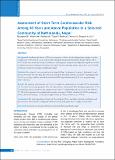Please use this identifier to cite or link to this item:
https://hdl.handle.net/20.500.14356/1764| Title: | Assessment of Short Term Cardiovascular Risk Among 40 Years and Above Population in a Selected Community of Kathmandu, Nepal |
| Authors: | Dhungana, R R Khanal, M K Pandey, A R Thapa, P Devkota, S Mumu, S J Shayami, A Ali, L |
| Citation: | Dhungana RR, Khanal MK, Pandey AR, Thapa P, Devkota S, Mumu SJ, Shayami A, Ali L. Assessment of Short Term Cardiovascular Risk Among 40 Years and Above Population in a Selected Community of Kathmandu, Nepal. J Nepal Health Res Counc. 2015 Jan-Apr;13(29):66-72. PMID: 26411716. |
| Issue Date: | 2015 |
| Publisher: | Nepal Health Research Council |
| Article Type: | Original Article |
| Keywords: | Cardiovascular disease CVD risk assessment CVD risk prediction Nepal |
| Series/Report no.: | Jan-April, 2015; |
| Abstract: | Background: Cardiovascular disease (CVD) risk assessment is effective for identifying whether people are at low or high risk of CVD events. It is also useful for determining the intensity of intervention. People with low risk of CVD can take more benefit by lifestyle modifications, whereas people at high risk need pharmacological intervention in addition. But, there is dearth of related study in Nepal. Therefore, this study aimed to assess short term CVD risk prediction in selected community of Kathmandu, Nepal. Methods:We conducted a cross-sectional study in Sitapaila Village Development Committee, Kathmandu, Nepal between November 2014 and April 2015. We, first selected the household randomly to enroll 347 participants with 18 to 70 years of age, and later assessed the short term CVD risk prediction among ≥ 40 years age group using WHO/ISH chart. Results: The mean age of respondents was 52years. The majority of participants were female (58.4%), homemakers (45.2%), from Newar ethnic group (31.9%), and without formal education (42.8%). Smoking was present in 21.7% of respondents, diabetes in 19.9 %, and hypertension in 53.6%. The ≥10% CVD risk was seen in 14.6% (95% CI: 9.2, 20) of the respondents. It was significantly associated with age (p<0.001), education (p=0.027), smoking (p = 0.002), cholesterol level (p = 0.021), systolic hypertension (p <001), and diabetes (p = 0.019). Conclusions: The study population is in high risk of developing CVDs in near future. Lifestyle modifications and pharmaceutical interventions to manage the risk factors among study population are highly recommended. Keywords: Cardiovascular disease; CVD risk assessment; CVD risk prediction; nepal |
| Description: | Original Article |
| URI: | http://103.69.126.140:8080/handle/20.500.14356/1764 |
| ISSN: | Print ISSN: 1727-5482; Online ISSN: 1999-6217 |
| Appears in Collections: | Vol. 13 No. 1 Issue 29 January - April 2015 |
Items in DSpace are protected by copyright, with all rights reserved, unless otherwise indicated.

